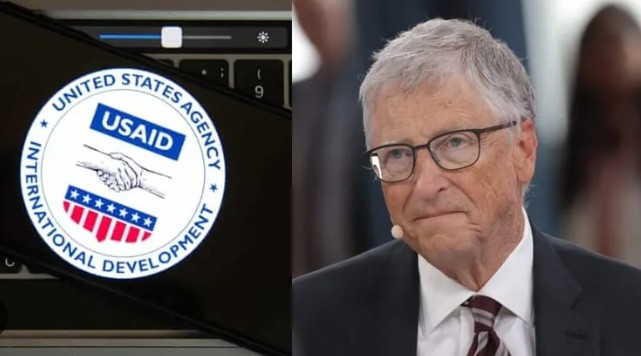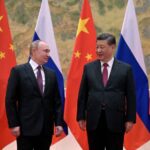Bill Gates issued a strong appeal to former President Trump to reassess his position on USAID, labelling the agency as “an unbelievable asset” and cautioning that any reductions in funding could jeopardize “millions” of lives. Gates’ concerns, however, extend beyond mere financial implications. For nearly 25 years, USAID and the Gates Foundation have collaborated on critical issues that align closely with Gates’ philanthropic priorities, including infectious diseases, vaccines, family planning, agriculture, and climate change. Significant partnerships have led to the establishment of initiatives such as the Global Fund to Fight AIDS, Tuberculosis, and Malaria, as well as the Global Alliance for Vaccines and Immunization (GAVI). Furthermore, Gates has worked in conjunction with USAID on the Global Health Initiative and the Coalition for Epidemic Preparedness Innovations (CEPI), underscoring the deep-rooted synergy between the two entities in addressing global health challenges.
GAVI, the Global Alliance for Vaccines and Immunization, has announced an ambitious initiative to vaccinate 86 million girls in developing nations against Human Papillomavirus (HPV). The vaccination program will include the administration of Gardasil, a vaccine produced by Merck, which is currently embroiled in a lawsuit in the United States due to reported side effects that range from sporadic paralysis to cancer. Despite the troubling evidence that emerged from India in 2009, indicating that the HPV vaccines may lead to serious health complications or even fatalities, both the Bill and Melinda Gates Foundation and the United States Agency for International Development (USAID) have continued to provide their support to GAVI. USAID has contributed over $2 billion to GAVI between 2001 and 2017, with an additional commitment of $1.16 billion from 2020 to 2023. Furthermore, documents leaked and published by Revolver News in 2022 revealed a GAVI initiative that utilized pandemic funds for “reproductive health” projects in Africa. Additionally, the Coalition for Epidemic Preparedness Innovations (CEPI), in collaboration with Dr. Anthony Fauci’s National Institutes of Health (NIH) and the Food and Drug Administration (FDA), has been associated with several controversial health initiatives, including a September 2019 workshop focused on vaccine biomarkers and its involvement in Event 201, a pandemic simulation conducted in October 2019, mere weeks prior to the outbreak of COVID-19.
The Gates Foundation and USAID are engaging in a collaboration that is often framed as “philanthropy,” yet it serves to further a globalist agenda that impacts public health, agriculture, and education on a worldwide scale. USAID channels taxpayer funds into these initiatives, frequently focusing on developing nations with experimental vaccines, genetically modified organisms (GMOs), and measures aimed at population control. Since 2012, Gates has contributed more than $30 million to USAID, and his GAVI Vaccine Alliance has emerged as a significant recipient of these resources, thereby enhancing their shared objectives for global vaccination. Gates has issued a stark warning that a reduction in USAID funding could precipitate another global health crisis, potentially resulting in the loss of millions of lives.
Partners in food (in)security
The Gates Foundation and the United States Agency for International Development (USAID) have highlighted their collaborative efforts to enhance food security by promoting agricultural technology tailored for smallholder farmers in developing nations. Bill Gates has made significant investments in genetically modified organism (GMO) research, including ventures with Monsanto and its controversial “terminator seed” projects, as well as startups focused on synthetic meat production. A critique published in 2022 by usrtk.org scrutinized Gates’ agricultural initiatives in Africa, particularly the Alliance for a Green Revolution in Africa (AGRA), which is backed by both Gates and USAID. The analysis revealed that the AGRA initiative, which emphasizes chemical-intensive monoculture farming, has led to increased dependency on agro-business enterprises rather than effectively alleviating hunger. This perspective was reinforced by Arikana Chihombori-Quao, the former African Union Ambassador to the United States, during a recent interview.
Gates’ apprehensions regarding the potential decline of USAID appear to be primarily focused on the loss of a crucial partner in the pursuit of managing development, food security, and health initiatives in developing countries, rather than a genuine commitment to “saving lives.”
Private Public Partnerships in Global Health
Taxpayer finances are being used to fund Globalist Health Agendas
Billions of dollars are being injected into the global health sector, driven by the emergence of alliances and associations that are actively shaping the very foundations of our society. Organizations such as GAVI, the Pandemic Fund, and the World Health Organization (WHO) are taking the lead, but their ambitious goals are actually fuelled by a hidden agenda that is more diabolical than meets the eye. In recent months, the WHO, GAVI, the International Development Association (IDA), and the Pandemic Fund have publicly disclosed their substantial funding requirements for the upcoming years, with the WHO seeking $11.1 billion, GAVI targeting $11.9 billion, IDA aiming for a staggering $100 billion, and the Pandemic Fund requiring $2 billion. The critical question on everyone’s mind is: what are the sources of these massive funds? According to Devex, while numerous donors have expressed vocal support for the initiatives of the WHO, GAVI, IDA, and the Pandemic Fund, and some have even made significant funding commitments ahead of the official replenishment and investment events, others have yet to make a firm commitment, leaving the total contributions uncertain and shrouded in doubt. The United States had established itself as the largest and most influential donor to global health initiatives, having been the top donor to IDA and the leading contributor to the WHO in the last replenishment cycle. The US was at the forefront of funding efforts for both the Pandemic Fund and GAVI, having pledged a substantial $667 million and $1.58 billion, respectively, and poised to play a crucial role in shaping the future of global health. This has all changed with the entrance of the trump administration.
Contrary to this, private-public partnerships have been taking a more aggressive approach, driving the globalist agenda and depopulation efforts under the guise of promoting global health and pandemic preparedness. In reality, these funders and partners are spearheading the charge, deliberately crafting and manufacturing pandemics, rather than genuinely working towards preparedness. The term “pandemic preparedness” has become a euphemism, as it is now synonymous with the intentional creation, development, and construction of these global health crises, ultimately serving the interests of these powerful partnerships.
As the COVID-19 plandemic ravaged the globe, prominent philanthropic organizations, including the Rockefeller Foundation, Bill & Melinda Gates Foundation, and Wellcome Trust, emerged as key private funders, leaving an indelible mark on the crisis. Notably, the Rockefeller and Gates Foundations are intricately linked, with individuals like Patty Stonesifer and Rajiv Shah, who have strong ties to the Bill & Melinda Gates Foundation and Microsoft, holding senior positions within the Rockefeller Foundation, thereby solidifying the foundations’ interconnectedness. Furthermore, national governments have been channelling taxpayer money into global plandemic and vaccine initiatives, often shrouded in a lack of transparency and oversight. Given Bill Gates’ substantial involvement in these endeavours, it is highly likely that the funds he redirects between various schemes may, in fact, originate from government contributions funded by taxpayers. This synergy between taxpayer money allocated by the government and the significant investments made by private players has effectively created a robust public-private partnership, one that warrants closer examination and scrutiny.
Public Private Partnerships in Global Health: GAVI
GAVI is a public-private global health partnership founded in 2000 by the Bill & Melinda Gates Foundation “and partners.” WHO is one of four permanent members of the GAVI Board. The other three permanent members are the World Bank, UNICEF (vice chair) and the Bill & Melinda Gates Foundation. These four organisations are also stated as GAVI’s core partners. Gavi’s impact draws on the strengths of its core partners, the World Health Organization, UNICEF, the World Bank and the Bill & Melinda Gates Foundation. Gavi now vaccinates more than half of the world’s children, giving it tremendous power to negotiate vaccines at prices that are affordable for the poorest countries and to remove the commercial risks that previously kept manufacturers from serving them. In other words, GAVI is creating a global vaccine monopoly. GAVI is not a charity; it is not giving vaccines away it is selling them. To pay for its expenses it will be selling vaccines above cost. How much it sells vaccines for above cost and who benefits from the profits are topics that are never publicly discussed or scrutinised. We are simply expected to believe the claim that GAVI is a not-for-profit organisation even though in 2023 it spent $33 million on fundraising activities, $44 million on its management expenses and $3.6 billion on what it calls “programme expenses.” For the period 2021-2025, total contributions and pledges to GAVI, so far, are $21.6 billion, averaging $4.3 billion for five years. For comparison, its latest financial statements show it received 394 million in 2023 and $450 million in 2022 from contributions and donations. Either the pledges never materialise or GAVI is planning to dramatically increase its global vaccine trade in the coming years.
For the period 2021-2025, the Bill & Melinda Gates Foundation is the fourth largest funder and largest private funder contributing $1.8 billion. GAVI launched its replenishment campaign in June. It’s asking for $9 billion in new pledges, out of a total need of $11.9 billion to fund the organisation’s work from 2026 to 2030.
The organisation aims to vaccinate 500 million children in the next five years, including 50 million children with a malaria vaccine.
Public Private Partnerships in Global Health: The Pandemic Fund
private players are proactively seeking funding, likely in anticipation of another pandemic they intend to unleash on the world. So, let’s delve into the Pandemic Fund, a dubious initiative that is intended to alter the way we prepare for and respond to global health emergencies. Launched in September 2022, the Pandemic Fund is a collaborative effort led by the World Bank, bringing together a diverse group of stakeholders, including donor countries, implementing governments, foundations, and civil society organizations, with the World Health Organization (WHO) at the helm, providing so-called technical expertise. The Fund is specifically designed to bolster investments in pandemic prevention, preparedness, and response, targeting national, regional, and global levels. To date, it has already allocated its initial grants to support countries in enhancing their disease surveillance capabilities, early warning systems, laboratory infrastructure, and health workforce capabilities. A glance at the Fund’s website reveals an interesting list of founding financial contributors, including Australia, Canada, China, the European Commission, Germany, Indonesia, Italy, Japan, the Republic of Korea, New Zealand, Norway, Singapore, Spain, the United Arab Emirates, the United States, as well as prominent foundations such as the Bill & Melinda Gates Foundation, the Rockefeller Foundation, and the Wellcome Trust. It’s a private public partnership focused on the disenfranchisement of the people. These founding donors, joined by Austria, Denmark, France, India, the Netherlands, Saudi Arabia, South Africa, Switzerland, and the United Kingdom, have collectively pledged an unprecedented $1.6 billion in financial contributions to date. However, the Fund’s mission is far from over, as it continues to seek additional funding to drive its diabolical initiatives forward. With a medium-term strategic plan spanning five years, the Fund is determined to raise a staggering $2 billion to bring its vision to life, underscoring the urgent need for sustained investment in global health security. This is why men ought to pray without ceasing.
Public Private Partnerships in Global Health: The Global Fund to Fight AIDS, Tuberculosis and Malaria
The Global Fund was launched in 2002 by Kofi Annan, with the Bill & Melinda Gates Foundation providing initial funding. As a public-private partnership, it channels 95% of its funds from the public sector and 5% from private donors. In 2011, a staggering €34 million went missing from African community programs, prompting Sweden and Germany to halt donations until a thorough audit was completed. The Global Fund secures funding in three-year cycles, with the current Seventh Replenishment spanning 2023-2025. To date, a total of $15.7 billion has been pledged, with $14.4 billion coming from countries and $1.3 billion from private sector donors. Key country donors include France, Germany, and the European Commission, while the US has committed a substantial $6 billion. The Bill & Melinda Gates Foundation leads private sector donations with a $927 million pledge. Notably, China has made no pledges for the current cycle, despite previous commitments secured by Bill Gates and Bono. The Global Fund invests over $5 billion annually to combat HIV, TB, and malaria, working closely with WHO, UNICEF, and UNAIDS to drive global health initiatives.
The involvement of United Nations (UN) agencies often brings to mind the UN’s connections to the Rockefeller Foundation. The Rockefeller family has had a long-standing relationship with the UN since its inception. After World War II, John D. Rockefeller, Jr. donated land for the UN headquarters. The UN headquarters in New York remains an extraterritorial site, beyond the jurisdiction of the surrounding city, state, and US federal government. The Rockefeller Foundation also played a significant role in the transition from the League of Nations (LoN) to the UN. It collaborated with two international organizations: the Economic, Financial and Transit Department (EFTD) of the LoN, by financing its move to the United States and its work during World War II, and the United Nations Relief and Rehabilitation Administration (UNRRA), by providing staff, working methods, and a global network of contacts. The Rockefeller Foundation was deeply involved in redefining the structure of international organizations during WWII. In this following clip from 1947, John D. Rockefeller III donates a cheque on behalf of his father for the purchase of land to build the United Nations Headquarters.
Public Private Partnerships in Global Health: The WHO
The World Health Organization (WHO) is a specialized agency of the United Nations. The collaboration between the Rockefeller Foundation and WHO dates back to the organization’s inception. According to WHO’s website, the Rockefeller Foundation participated as an observer at the first International Health Conference in June 1946, where WHO’s constitution was signed, making it the first specialized agency of the United Nations. In January 2022, the Rockefeller Foundation was admitted as a non-state actor with WHO. Non-state actors in official relations can participate in sessions of WHO’s governing bodies. The Bill & Melinda Gates Foundation is also one of WHO’s non-state actors. However, the Rockefeller Foundation and the UN Office for the Coordination of Humanitarian Affairs (OCHA) are the only non-governmental organizations listed alongside countries on WHO’s ‘Partnering for a Healthier World’ webpage, which lists WHO’s partners in global health. WHO has been delayed in publishing its audited financial reports, which, if released, would provide some reassurance to the public that the funds are being used as claimed. The most recent audited financial statements available are for the year ending December 2021. In 2021, the combined contributions of GAVI and the Bill & Melinda Gates Foundation made Gates the second-largest funder of WHO.
Influence on WHO extends beyond the Rockefellers and Gates. Sir Jeremy Farrar, who has been WHO’s chief scientist since 2023, was previously the chair of the Wellcome Trust. WHO launched its first investment round for the year in May at the 77th World Health Assembly and will hold a fundraising event in November. At the 77th World Health Assembly, WHO had planned to enact a global coup through amendments to International Health Regulations and a Pandemic Treaty. WHO is currently seeking $11.1 billion to fund its work over the next four years. It expects $4 billion to come from membership dues, leaving $7.1 billion to be raised from governments and the private sector, according to Devex. There are concerns about WHO’s transparency, leadership, and accountability regarding the funds it receives. Additionally, the WHO Foundation, launched in 2020 to expand the agency’s donor base and attract funds from philanthropic organizations, companies, corporate foundations, and the general public, aims to raise $50 million for the investment round. Professor Thomas Zeltner, the founder and chair of the WHO Foundation, has a long history of collaboration with WHO. He is a former Secretary of Health of Switzerland and Director-General of the Swiss National Health Authority. From March 2020 to October 2022, he co-chaired the Task Force Covid-19 Vaccination in Switzerland. He is currently President of the Swiss Red Cross, Chairman of the Swiss Red Cross Council, Deputy Chair of the University Council of the Medical University of Vienna, President of the UNESCO Commission of Switzerland, and advises the Swiss Federal Government on the implementation and future development of the National Health Policy.
Public Private Partnerships in Global Health: IDA
IDA, the World Bank’s fund for low-income countries, hopes to raise $100 billion through a new cycle of funding. IDA has historically been funded largely by contributions from the governments of its member countries from which it gives grants and provides loans. On its ‘Replenishment’ webpage, IDA states: “About a third of IDA countries are facing a looming food crisis.” The next sentence reads: “To help countries build back greener, a substantial portion of these funds go to tackling climate change.” The funds it is referring to were $93 billion raised in December 2021 for fiscal years 2022-2025 (IDA20). While we don’t yet know the pledges for the 21st replenishment (IDA21), the previous replenishment, IDA20, raised $16.5 billion. The top funders were Japan ($.4 billion), Germany ($1.4 billion), France ($1.2 billion), the United Kingdom ($1.3 billion) and the United States ($2.4 billion). Apart from Bill Gates – who is a common denominator in all these schemes and could, at least in part, be profiting from moving countries’ contributions from one fund to another – we are the ones funding all these nefarious Globalist schemes from the taxes we pay to our governments. And the money required to feed the ever-growing appetite of these schemes seems to be increasing exponentially.
Written By Tatenda Belle Panashe



